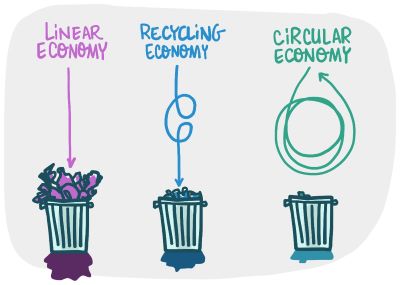What is a circular economy?
There are many different definitions of a circular economy. However, there is a consensus that the following elements form the core of this model:
- Optimising the use of resources;
- Decoupling economic growth from the consumption of natural resources.
The European Commission defines a circular economy as one in which products and materials retain their value for as long as possible; waste and resource use are minimised; and, when a product reaches the end of its life, its resources are maintained in the economic cycle to be used again and again in order to re-create value.
A circular economy covers the entire life cycle of products and services, from extraction to waste management. It aims to maintain the value and usefulness of products and resources for as long as possible, going beyond the vision of simple waste management or resource efficiency in production processes. The use of renewable resources is encouraged, while ensuring the preservation and generation of natural capital, including biodiversity and ecosystems.
Certain circular practices can help prevent waste: sharing, renting, re-using, repairing, refurbishing and recycling. The term "circular" is used, because these different practices create a set of loops that reintegrate materials, resources and products throughout the economic cycle: extraction of raw materials, design, manufacturing, distribution, consumption, use of goods and waste management. In a 100% circular economy, the notion of waste no longer exists!
What about the linear economy?
A linear economy is opposed to the notion of a circular economy. This economic model consists of extracting raw materials, manufacturing products, consuming them and finally disposing of them. This type of path is characterised as "linear". In other words, the raw materials used end up becoming and remaining waste. An economic model like this has negative repercussions both on the environment and the economy.
So why switch to a different economic logic?
A linear economy leads to the consumption, and even over-consumption of resources, as well as the production of waste. By preventing the creation of waste and reducing resource extraction, a circular economy provides food for thought and solutions for the major environmental and economic challenges represented by natural resource scarcity, the loss of biodiversity, climate change and deforestation. A circular economy provides concrete proposals for action to transform our economic model and make it more viable and sustainable, thereby enabling us to re-shape our consumer society, which is now approaching its limits.
What's more, the circular economy offers a series of economic benefits to our societies. Extending the lifespan of goods and transforming waste into new resources represents new ways of reducing costs for producers and consumers alike. It also enables better control of production supply chains, and greater resilience for companies in the face of crises.
Finally, a circular economy also calls on new skills and knowledge to enable greater re-use, re-utilisation and recycling, and thus promotes the re-localisation of certain know-how while creating local employment.
More than just better waste management

Eco-design, repair, sharing, economy of functionality, recycling, upcycling, industrial symbiosis, waste recovery, re-use, extending product lifespans... A circular economy actually encompasses an entire range of practices, each of which offers different solutions to producers and consumers. Each of them works towards the same goals: optimising the use of resources and keeping raw materials in the economic cycle. Together, these different solutions form a toolbox from which every citizen, company and public authority can draw to limit their impact on the use of resources.
And these solutions are far from being limited to product end-of-life and recycling! In fact, many of them come into play at the production, consumption or utilisation stages. Recycling alone is not enough to prevent the creation of waste. As such, a circular economy should not be confused with a recycling economy. While recycling is indeed a facet of a circular economy, it is only a partial solution: Not only does it require a lot of energy and chemical materials to be implemented, but it is rarely possible to recycle materials indefinitely. Circularity offers many other complementary, and often more effective, solutions that enable us to optimise our resources even further.
Et pour vous...
Vous aimeriez intégrer l'économie circulaire dans votre vie quotidienne ? De nombreux gestes peuvent participer à nous assurer un avenir durable : réparer, partager, réutiliser... Découvrez ce que vous pouvez mettre en place !
Vous travaillez en entreprise ? L'économie circulaire peut vous amener de nombreux avantages : nouveaux débouchés, réduction de votre consommation de matières premières et d'énergie, augmentation de votre compétitivité... Retrouvez-les ici.
Vous travaillez au sein d'un pouvoir public ? Nous vous proposons des rencontres inspirantes, un accompagnement (sur candidature) et des sources d'informations. Nous vous expliquons cela en détails ici.

